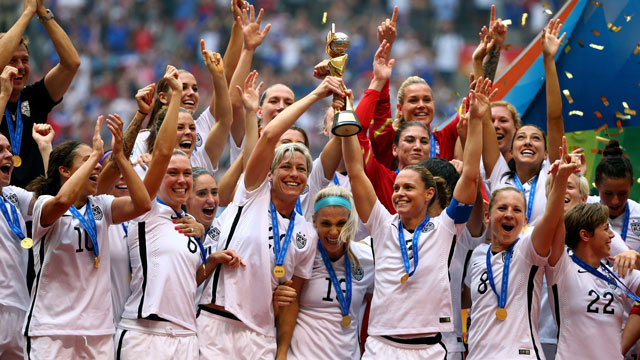Equality of Women’s Soccer: Has it Arrived?
December 17, 2015
The first documented evidence of football was in China 500-300 BC. They called the game “Tsu Chu” and it involved the kicking of a leather ball stuffed with fur.
Over the following centuries other countries such as Japan, Alaska, Italy, Scotland, England, Greece, Mexico and even American Indians all developed different early versions of the game football for men.
Football was introduced as an official sport in the mid-19th century, and England was the first to establish the game rules.
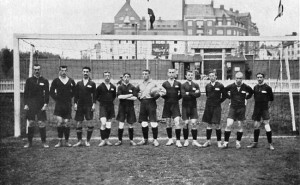
Russian Empire Football Team at the 1912 Summer Olympics.
In 1863 the sport of football was officially introduced to America, but it wasn’t until the mid-20th century that the game became popular here. America was the only country in the world to later call the sport soccer because it had already invented a very different version of what it called football.
In 1904, The Federation Internationale de Football Association (FIFA) was formed in Paris, which brought organization to the international world of football.
The First Women’s Soccer team ever recorded in the world was in 1917 called, the “Dick, Kerr Ladies” Football Club. This team consisted of women employed during the First World War who attracted strong crowds and helped to raise money for injured service men.
During their first game against St. Helen Ladies at Goodison Park in Liverpool, there was a crowd of thousands of spectators, selling out the small stadium.
However, in 1921 after seeing how popular the women’s teams were becoming, England’s Football Association took notice and saw them as a threat to the men’s teams. In order to keep the men’s sport the most popular, they placed a ban on women’s soccer.
Subsequently, the first organized women’s soccer league and teams in the United States were not created until 1951, years after the development of the game and the establishment of men’s leagues. The league consisted of four teams but did not last very long. They played two seasons with full schedules, before ending due to lack of money and support.
Title IX, created in 1972, was a law prohibiting the discrimination on the basis of sex in any federally funded education program or activity, including the sport of soccer. This helped push the support of women’s sports and allowed for more female athletes to receive scholarships and to attend college. This law also helped establish soccer as a sport for women at the collegiate and even the high school level.
Monique Conroy, Assistant Coach of Girls’ Varsity Soccer, says, “In many ways, the girls and boys prep school league are equal, schedules, coaching, etc. I do believe that many schools fund the boy’s team with more financial aid.”
Inequality of the sport in different educational facilities is still experienced today.
In 1977, the first varsity women’s soccer program began at Brown University, a century after men’s colleges such as Rutgers had started their men’s programs.
In 1985 the first game played by the United States Women’s National Team took place, nearly 70 years after the men’s. The team had a lot of pressure riding on their shoulders because this game was said to predict how much support and attention the women’s team would receive. Unfortunately, they gave into that pressure losing 1-0 after a hard fought battle against Italy.
Mrs. Conroy says, “It was a very different time when I was growing up. Soccer was in the early stages of development as a sport for girls. There was a world cup for men but none for women.”
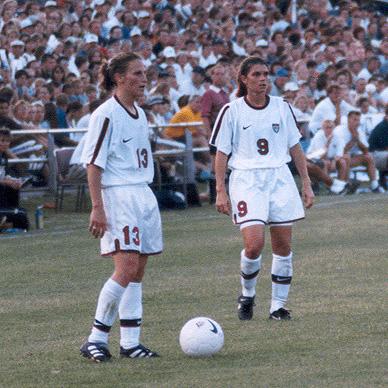
Kristine Lilly (left) and Mia Hamm, players of the 1991 U.S Women’s National team that won the first Women’s World Cup.
In 1991, things changed for Women’s Soccer in America.
The first-ever FIFA Women’s World Cup was held in China, 61 years after the men’s. This tournament was a major milestone for women’s soccer globally and especially in the U.S because they were the first victors of this event winning in the finals against Norway 2-1.
The success of women’s soccer in the U.S continued in 1996 when the women’s national team won the first-ever women’s soccer gold medal at the 1996 Atlanta Olympics, defeating China 2-1 in the championship game. This was the first year women’s soccer had been accepted as an Olympic Sport.
Jen Fulcher, Williston Girls’ Varsity Head Coach, says, “A big moment for me was going to the Olympics in 1996. I went to the women’s soccer final with the U.S playing and there were over 70,000 people there. A crazy crowd full of men, women, girls and boys all cheering for the U.S team.”
She continued, “I teared up knowing how far women’s soccer had come. I never thought I would see the day of a sold out stadium watching women’s soccer, having grown up in a time when I had a hard time finding a girls team to play on. It was incredible.”
Women’s soccer in the U.S was taking off, gaining the interest of young girls, giving them role models, and goals to strive for with the sport. Programs were starting for females and most schools, if they hadn’t already, introducing girls’ soccer programs.
Mrs. Fulcher says, “When I was a kid I had to play on boys teams as there were no girls’ teams. My town tried to cut soccer when I was in middle school, for girls, but kids and parents fought back. I played on my first girls’ team in 8th grade.”
The national women’s team continued to contribute to the development of the game for women, coming back to win their second World Cup title in 1999 in front of over 90,000 fans in California. This was the largest ever attendance for a women’s sporting event in world history. The team defended China to a 0-0 tie through 90 minutes and overtime, they went on to defeat the Chinese 5-4 in penalty kicks. FIFA announced that it was most successful women’s sporting event ever.
After this major accomplishment by the team, the women’s national players started appearing on every top news program, at the White House, and on the cover of Time, Newsweek, People and Sports Illustrated.
In the year 2000, the United States women maintained the momentum from their historic Women’s World Cup title, maintaining a record of 26-6-9 for the year. That same year the U.S. Women’s team won a total of six tournament titles and claimed a silver medal at the 2000 Summer Olympics, losing in overtime to rival, Norway.
Later that same year the first-ever Women’s United Soccer Association was formed.
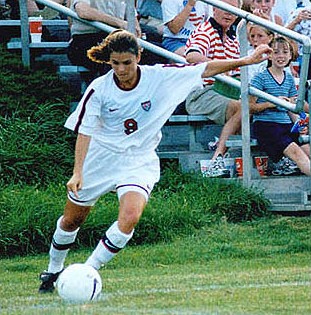
Mia Hamm, first ever FIFA Women’s World Player of the year.
In 2001 Mia Hamm, a player for the U.S Women’s National Team, was named the first-ever FIFA Women’s World Player of the Year, another major accomplishment for the U.S.
In 2002 the U.S. Women’s National Team qualified for their fourth consecutive FIFA Women’s World Cup, set to take place in China in 2003, after winning the 2002 CONCACAF Gold Cup with a 2-1 victory in overtime against Canada.
Around this time, more than the Women’s National team were making a name for themselves.FIFA decided to move the tournament from China due to the outbreak of Severe Acute Respiratory Syndrome; SARS. The U.S. volunteered to host the tournament being faced the task of organizing it all with just four months of preparation. The U.S. Women’s National Team won Group A, beat Norway in the quarterfinals 1-0, but were stunned by Germany with a 3-0 loss in the semifinals. The U.S went on to beat Canada in the third-place match.
The U.S. U19 Women’s National Team defeated the host, Canada 1-0 in overtime to win the FIFA U19 Women’s World Championship. A new national team, the U17 Women’s National Team, was established in October, proving to all that the legacy of the U.S. Women’s National Team was secure.
In 2003 the Women’s United Soccer Association ended after playing three full seasons. While there was some demand for the sport, it was not as great as expected, and the WUSA had lost around 100 million dollars in funding regardless of the success of the women’s national programs.
In 2004, the U.S. Women’s National Team won every tournament entered and earned gold at the 2004 Olympics. Other tournament titles included the Algarve Cup, the Four Nations Tournament and the CONCACAF Regional Olympic qualifying tournament. At the youth level, the Under-21 Women won their seventh Nordic Cup in eight years and the Under-19 Women finished third at the FIFA U-19 Women’s World Championship.
In 2005 the U.S. Women’s National Team ended the year undefeated and without allowing a single goal, which is considered to be a perfect season.
In 2007, the U.S. women maintained their two-plus year undefeated record, looking to take their streak into the FIFA Women’s World Cup. They were placed into the toughest group in Women’s World Cup history. They qualified in first place after three difficult games against Korea, Sweden and Nigeria. The U.S. played in the semifinals, but was unable to defeat Brazil, securing third place for the second consecutive World Cup with a win over rival, Norway.
Yet with all these accomplishments of the U.S women and little for the U.S men, the game of soccer was still unequal between the sexes.
Aaron Denkins, Bermuda National Academy Coach, says, “’I have coached in the US, Jamaica, Haiti, Puerto Rico, Cayman Islands and in Bermuda and have seen no comparison to the support and growth of women’s soccer in the US. In all [other] countries the male side of the game takes precedence over the women’s game.”

Young girls playing a game of soccer.
Although the American Women’s National teams were seeing more success than the men ever had, they still lacked equal support, funding and programs.
The first Women’s Professional Soccer League game wasn’t played until early 2009, 52 years after the men’s. The newly formed Women’s Professional Soccer League consisted of five teams.
Not even three years later, in 2012, the Women’s Professional Soccer League announced that the league would cease to continue, because of lack of support. However, the national program, once again, continued to move forward.
Mrs. Fulcher says, “Women’s soccer still has work to do. I got to go to the World Cup in Canada this summer, [2015] the level of soccer was amazing and the crowds so much fun! The women however played on turf and this would never be allowed in a men’s World Cup. Fields. Training. Pay. Building up professional league. Still work to be done.”During the 2011 Women’s World Cup in Germany, the U.S. lose out in penalties to Japan in the final after playing to a 2-2 draw through 120 minutes. However four years later in the summer of 2015, the U.S Women’s National Team found themselves once again in the World Cup final, that took place in Canada, where they were victorious over Japan winning 5-2.
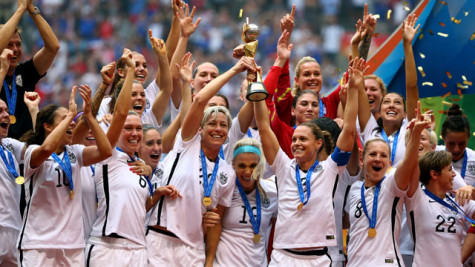
USA Women’s National Team celebrating winning the Women’s 2015 World Cup.
Women’s Soccer in America to this day has yet to become equal all around to men. Nationally and globally. It is a fight for women to gain the support and recognition they deserve in all age groups, financially and developmentally.
Coach Denkins says, “I think that unless a separate governing body is created that is solely dedicated to women, with separate funding, equality will never be achieved.”
It is evident that performance-wise in America, women’s soccer has arrived but unfortunately all-around equality still has not.
